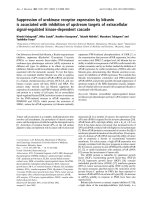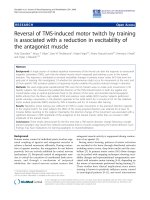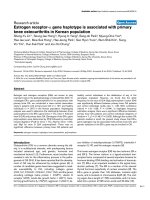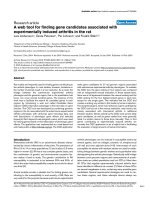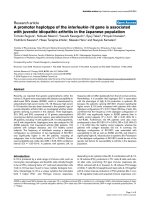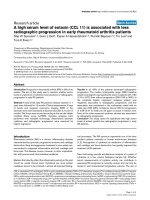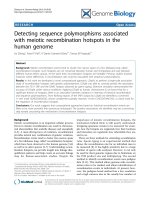Isoprene degradation by soil bacteria associated with wild himalayan cherry in tropical forests thailand
Bạn đang xem bản rút gọn của tài liệu. Xem và tải ngay bản đầy đủ của tài liệu tại đây (2.09 MB, 58 trang )
THAI NGUYEN UNIVERSITY
UNIVERSITY OF AGRICULTURE AND FORESTRY
NGUYEN KIM LUYEN
ISOPRENE DEGRADATION BY SOIL BACTERIA ASSOCIATED WITH
WILD HIMALAYAN CHERRY IN TROPICAL FORESTS – THAILAND
BACHELOR THESIS
Study mode : Full-time
Major
: Environmental Science and Management
Faculty
: Advanced Education Program Office
Batch
: 2014 - 2018
Thai Nguyen, 20/09/2018
DOCUMENTATION PAGE WITH ABSTRACT
Thai Nguyen University of Agriculture and Forestry
Degree Program
Bachelor of Environmental Science and Management
Student name
Nguyen Kim Luyen
Student ID
DTN1453110084
Thesis Title
Supervisors
Isoprene Degradation by Soil Bacteria Associated with
Wild Himalayan Cherry in Tropical Forests-Thailand
Dr. Tho Huu Nguyen
Assist. Prof. Thararat Chitov
Supervisor’s
Signature
Abstract:
Isoprene is a Biogenic Volatile Organic Compound (BVOC), which represents nearly
one-third of total global hydrocarbon released in the atmosphere. Isoprene can easily
react with oxides of nitrogen to form tropospheric ozone that is harmful for life.
Broadleaf trees and shrubs are the greatest source of isoprene emission. Certain
proportion of isoprene is absorbed in soil, which can be reduced by some soil bacteria.
The aims of this research work are to measure isoprene degradation in the terrestrial
environment, with a particular focus on soil associated with Wild Himalayan Cherry
trees, one of the framework tree species used in forest restoration, and to isolate bacteria
responsible for isoprene degradation. Soil samples taken from underneath 6 Wild
Himalayan Cherry trees in Mae-Sa Mai restoration area were examined for their
properties and rates of isoprene consumption in soil incubated with isoprene was
measured using Gas Chromatography-Flame Ionization Detector (GC-FID). Bacteria
responsible for isoprene consumption were isolated from soil, using minimal medium
(agar and broth) supplemented with isoprene as the sole carbon source. The bacterial
isolates were characterised based on the features of colony and cell morphology and
some biochemical tests. It was found that the soil samples had the average pH of 4.4,
moisture content of 40.8%, and total viable microorganisms of 5.3106 CFU/g.
i
Consumption of isoprene by soil microorganisms was observed in the combined soil
sample; which occurred at a constant rate during the first 4 days of incubation of the soil
sample with isoprene and remained unchanged afterwards. Some of the soil bacterial
isolates associated with Himalayan Cherry were capable of utilising isoprene as the sole
carbon source. Morphological and biochemical characterisation revealed these bacterial
isolates to be of different types. These bacterial isolates will be subjected to further
identification and characterisation of their role in isoprene degradation.
Key words
isoprene degradation, soil bacteria, Wild Himalayan Cherry
Number of pages
49
Date of
24/09/2018
Submission:
ii
ACKNOWLEDGEMENT
First of all, I would like to thank International College and The ASEAN
International Mobility for Student Program for providing opportunity for me to doing
my undergraduate research in Chiang Mai University.
I would also like to thank Microbiology Division, Department of Biology,
Faculty of Science, Chiang Mai University for their technical, financial, and scientific
support.
I am extremely grateful to my project supervisor Assistant Professor. Dr Thararat
Chitov at Chiang Mai University for her excellent advice and support throughout this
study. Being a member of your research group has been a privilege and this work would
not have been possible without your immense knowledge and true guidance.
I am also very grateful to my internship supervisor Dr. Tho Huu Nguyen at Thai
Nguyen University of Agriculture and Forestry for his insightful advice, discussions and
comments which brought an added value to this research work.
I am deeply grateful to the staff of FORRU attached to the Biology Department,
Faculty of Science, Chiang Mai University for supporting me to conduct my research.
I thank all members of SCB 2806 laboratory especially Ms. Tuangporn Uttarothai
for being around to give me advice and assistance in the laboratory. Thank you all for
your support, friendship, and encouragement and for making the time I spent at
Microbiology Division very memorable.
Finally, a special thank goes to my family and friends for their unequivocal
support and faith in me.
Author
Nguyen Kim Luyen
iii
TABLE OF CONTENT
DOCUMENTATION PAGE WITH ABSTRACT .......................................................... i
ACKNOWLEDGEMENT ............................................................................................. iii
TABLE OF CONTENT ................................................................................................. iv
LIST OF TABLES ......................................................................................................... vi
LIST OF FIGURES .......................................................................................................vii
LIST OF ABBREVIATIONS ..................................................................................... viii
PART I. INTRODUCTION ............................................................................................ 1
1.1. Research rationale .................................................................................................... 1
1.2. Research’s objectives ............................................................................................... 2
1.3. Research questions and hypothesis .......................................................................... 2
1.3.1 Research questions ................................................................................................. 2
1.3.2 Hypothesis .............................................................................................................. 2
1.4. Limitations ............................................................................................................... 2
1.5. Definitions .............................................................................................................. 3
PART II. LITERATURE REVIEW ................................................................................ 4
2.1. Significance and Production of Isoprene .................................................................. 4
2.2. Significance of Isoprene .......................................................................................... 6
2.3. Isoprene’s Biological Roles ..................................................................................... 7
2.4. Isoprene Emission by Plants .................................................................................... 7
2.5. Soil as a sink for isoprene: the effects of location, season, and isoprene
degradation ...................................................................................................................... 8
2.6. Isoprene Degradation by Soil Bacteria ..................................................................... 9
2.7. Isoprene-degrading Bacteria and Forest Restoration ............................................. 10
PART 3. MATERIALS AND METHODS ................................................................... 13
3.1. Equipment and Materials ........................................................................................ 13
3.1.1. Equipment ............................................................................................................ 13
3.1.2. Microbiological Media, Reagents, and Chemicals .............................................. 13
3.2. Methods .................................................................................................................. 14
iv
3.2.1. Soil Sampling ...................................................................................................... 14
3.2.2. Determination of soil characteristics ................................................................... 14
3.2.3. Determination of isoprene degradation by microorganisms in
soil associated with Wild Himalayan Cherry trees ....................................................... 15
3.2.4 Isolation of soil bacteria capable of degrading isoprene ..................................... 15
PART IV. RESULTS .................................................................................................... 18
4.1. Physical and Chemical Characteristics of Soil Samples ....................................... 18
4.2 Microbiological characteristics of soil samples ...................................................... 18
4.3 Isoprene degradation by soil microorganisms ......................................................... 19
4.4. Isolation of bacteria capable degrading isoprene ................................................... 21
4.5. Characterisation of isoprene-degrading bacterial isolates ..................................... 24
PART V. DISCUSSION .............................................................................................. 27
5.1 Physical and Chemical characteristics of Soil Samples Beneath
Wild Himalayan Cherry Trees. ...................................................................................... 27
5.2. Microbiological Characteristics of Soil Samples ................................................... 28
5.3. Investigation of Isoprene Degradation by Soil Microorganisms ........................... 29
5.4. Characterisation of Isoprene-Degrading Bacterial Isolates .................................... 29
PART VI. CONCLUSION ............................................................................................ 31
REFERENCES .............................................................................................................. 32
Appendix A.................................................................................................................... 39
Appendix B .................................................................................................................... 43
Selected Details of Analytical Procedures and results .................................................. 43
Standard graph of isoprene measuring by GC-FID ....................................................... 43
Appendix C .................................................................................................................... 48
v
LIST OF TABLES
Table 4.1 Location and basic characteristics of soil samples. ....................................... 18
Table 4.2 Count of total viable microorganisms in soil. ............................................... 19
Table 4.3 Isoprene consumption by soil microorganisms. ............................................ 20
Table 4.4 Characteristics of bacterial colony morphology............................................ 21
Table 4.5 Cell morphological characteristics of isoprene-degrading bacterial isolates 25
Table 4.6 Biochemical characteristics of isoprene-degrading bacterial isolates ........... 26
vi
LIST OF FIGURES
Figure 2.1 The chemical structure of Isoprene. (CH 2=C(CH2) CH=CH2 )
(Source: Polymer Science Learning Center, 2000) ..................................................... 4
Figure 2.2 Isoprene cycle by sources and sinks (Source: McGenity, 2018) .................. 5
Figure 2.3 Wild Himalayan Cherry (Source A: Chaiudom, 2018; B, C, D:
Thakur, 2015) .............................................................................................................. 12
Figure 4.1 The decrease of isoprene due to consumption by soil microorganisms. ..... 20
Figure 4.2 Bacteria isolates grew on MM agar plate. ................................................... 22
Figure 4.3 The isolates were more turbid after 1st cultured in MM broth. ................... 23
Figure 4.4 The isolates were more turbid after 2nd cultured in MM broth. .................. 24
vii
LIST OF ABBREVIATIONS
Abbreviation
T
Explanation
Temperature
MC
Soil moisture content
CFU
Colony Forming Unit
MM
Minimum medium
G+
Gram positive
G-
Gram negative
+
Positive
-
Negative
μl
microlitre
ml
millilitre
L
litre
mm
millimetre
pA
peak area
Tg
teragram
viii
PART I. INTRODUCTION
1.1. Research rationale
Atmospheric pollution is currently one of the major threats to human health and
the environment. Due to this, it is important to gain a thorough understanding of the
cycling of atmospheric pollutants. Some of the atmospheric pollutants are formed from
the reactions between non-pollutant compounds, such as Biogenic Volatile Organic
Compounds (BVOCs). Because of their existence in large amounts, BVOCs play an
important role in atmospheric chemistry, climate conditions, and air quality. Isoprene
(2-methyl-1,3-butadiene [C5H8]), one of the BVOCs, represents approximately one-third
of total global hydrocarbon released into the atmosphere. It is the second-most abundant
volatile organic compound in the atmosphere after methane. In areas with elevated levels
of oxides of nitrogen, the oxidation of isoprene leads to the formation of tropospheric
ozone, which is harmful to health and ecosystems. Ozone is a major pollutant and
greenhouse gas (Chameides et al., 1992), which also contribute to global warming.
Other effects of atmospheric isoprene oxidation include the formation of tropospheric
carbon monoxide, global transport of nitrogenous compounds, extended residence times
of other atmospheric trace gases, and the formation of secondary organic aerosols
(Monson and Holland, 2001). The sources of atmospheric isoprene have been relatively
well-studied, with terrestrial plants accounting for 90% of isoprene emissions to the
atmosphere (Pacifico et al., 2009). Besides, Pegoraro (2005) reports that soil acts as a
significant atmospheric sink of isoprene (3% of global emissions).
Although the proportion of isoprene in soil is small, compared with that in the
atmosphere, the amount is significant. Since soil surface is the interface between the
absorbed isoprene in soil and atmospheric isoprene, it is hope that reduction of isoprene
in soil would affect the total amount of isoprene in the atmosphere. Previous research
works have demonstrated that some soil microorganisms possess the ability to degrade
isoprene, and these organisms have association with certain types of plants. Since the
isoprene flux between soil and atmosphere and the interactions between plant and the
associated isoprene-degrading microbes are not yet well understood, this research work
was designed to address these questions. Since this work was carried out in the North of
1
Thailand where deforestation is an issue of concern, one type of plant is chosen as a
subject of this study: Wild Himalayan Cherry. This is a tree significant in forest
restoration and it has additional values in tourism and medicine. It is expected, through
this approach of study, that more clarity would be gained in the understanding of
isoprene flux and isoprene degradation in soil by soil microorganisms. Moreover, it is
hoped that plant-microbe interactions, especially between Wild Himalayan Cherry and
its rhizospheric bacteria capable of degrading isoprene would be more clearly
understood.
1.2. Research’s objectives
Determine isoprene-degradation rates by soil microorganisms associated with
Wild Himalayan Cherry trees
Isolate and characterize soil bacteria responsible for isoprene-degradation
1.3. Research questions and hypothesis
1.3.1 Research questions
What is the relationship between the absorbed isoprene in soil and atmospheric
isoprene?
Are there any relationships between plant and the associated isoprene-degrading
microbes?
What are the characters or abilities of isoprene-degrading bacteria in soil?
1.3.2 Hypothesis
Bacteria in soil associated with Wild Himalayan Cherry trees in tropical forest
could absorb isoprene.
1.4. Limitations
Limited time is the main culprit minimizing the range of scope of this study. Firstly,
one of the main factors affecting the number of microorganisms in soil is season.
Therefore, collecting soil samples in the rainy season in Thailand was the reason leading
to the lower quantity of bacteria collected. Secondly, limited time is the main culprit
minimizing the range of scope of this research and hindering further study about
identification of bacteria.
2
1.5. Definitions
Isoprene is one of the Biogenic Volatile Organic Compounds, represents
approximately one-third of total global hydrocarbon released into the atmosphere.
Soil bacteria is the microorganisms live in soil.
3
PART II. LITERATURE REVIEW
2.1 Significance and Production of Isoprene
Biogenic Volatile Organic Compounds (BVOCs) play an important role in
atmospheric chemistry and the carbon cycle. Around 1,150 Tg of the hydrocarbons in
the atmosphere are BVOCs (Guenther et al., 1995). Non-Methane Hydrocarbons
(NMHC) and short chain (<10 carbon atoms) volatile carbon-based molecules make up
most of these BVOCs (Shaw, 2001). Isoprene is one of these NMHCs and represents
approximately one third of total global hydrocarbon release (Guenther et al., 2012).
Isoprene is also known as 2-methyl-1,3-butadiene (C5H8) (Figure 1.1) with the boiling
point of 33°C and a mass of 68.0626 g/mol (Seinfeld and Pandis, 2012). It is a non-polar
compound, and therefore has low water solubility (Sharkey, 1996a). Isoprene is denser
than air, uncharged, and highly reactive in the atmosphere due to its two carbon-carbon
double bonds (Seinfeld and Pandis, 2012). This means that it has important effects on
atmospheric chemistry (Pacifico et al., 2009).
Figure 2.1 The chemical structure of Isoprene. (CH 2=C(CH 2) CH=CH 2).
(Source: Polymer Science Learning Center, 2000)
Isoprene emissions are estimated to be 600 million tons per year (Guenther et al.,
2006). The vast majority of isoprene is produced by trees and shrubs, with broadleaf
trees accounting for 51% of total production, and shrubs for 46% (Figure 1.2) (Guenther
et al., 2006). In addition to plants, many animals also produce isoprene (Sharkey,
1996a). However, no global data is available for isoprene emission from soils, animals
or bacteria, although it seems unlikely that these have a significant impact (Guenther et
al., 2006).
4
Figure 2.2 Isoprene cycle by sources and sinks (Source: McGenity, 2018)
Isoprene emission from human is estimated to be 17 mg/day on average. Human
activity can affect isoprene production. For example, changing in land use due to
increasing demand for biofuel crops, such as poplar or oil palm, can increase isoprene
emission in the atmosphere. An example for this is seen in the increase of oil palm
plantation in Malaysia. In 2009, Malaysia had 13% oil palm plantation area, which
increased from 1% in 1974. By 2014, the oil palm plantation took up to approximately
16% of land mass, which was about at 5.2 million hectares (Armstrong, 2013). The
increase of isoprene emission by human’s activities combined with the warming
climate’s effect on isoprene production by plants is predicted to contribute to a
substantial increase in isoprene emissions in the future (Sanderson et al., 2003a).
Atmospheric isoprene concentrations vary depending on the tree species, tree
coverage in the area, and the air temperature (Wagner and Kuttler, 2014). Higher
isoprene concentrations are found in hot climates, such as tropical rainforests and
deciduous forests, than in the regions with more temperate climates (David et al., 1991).
For example, in Amazonia in 1998, isoprene concentrations ranged from 4 to 10 ppb,
and in a forest in Tennessee (USA), from 3 to 10 ppb (Baldocchi et al., 1995); whereas
in Essen, Germany, isoprene concentrations are typically between 0.13 and 0.17 ppb
during the day, and around 0.01 ppb at night time (Wagner and Kuttler, 2014). In
5
Shanghai (China), a warmer urban environment near large forests, isoprene
concentrations ranged from 1 to 6 ppb, and in Venezuela’ isoprene concentrations
reached 3 ppb in a number of locations (Donoso et al., 1996). Low isoprene
concentrations can be found near marine environments, which were between 0.001 and
0.01 ppb (Lewis et al., 1997).
2.2 . Significance of Isoprene
As isoprene is highly reactive and is produced in significant quantities, it is
regarded as a very important biogenic hydrocarbon (Seinfeld and Pandis, 2012).
Isoprene reacts in the atmosphere in a number of ways, however, the main reactions are
through the reactions with hydroxyl radicals (OH) and nitrogen oxides (NOx). One of
the major problems with isoprene is that its reactivity with nitrogen oxides produces
tropospheric (low level) ozone. In the upper atmosphere (stratosphere), ozone provides
protection from UV light; but in the lower atmosphere (troposphere), ozone is
undesirable as it harms human and plant health and is a greenhouse gas (Sanderson et
al., 2003b).
The safe limit of ozone recommended by the World Health Organisation (WHO)
is 60 ppb (WHO, 2000), a figure that is sometimes exceeded, particularly in eastern USA
and China (Sanderson et al., 2003b). At 80 ppb ozone level, there is a significant
decrease in pulmonary function and increase in respiratory problems, including
inflammation and changes in responsiveness. Longer term exposure to ozone levels
between 120 and 250 ppb has been shown to cause changes in the epithelium cells in
the airways and connective tissues in the lung, often resulting in fibrotic changes (WHO,
2000). An estimate of 1365 deaths was predicted caused by ozone formed from
increased isoprene reacting with NOx (Ashworth et al., 2013). In addition to effects on
human, ozone can cause significant damage to ecological systems, microbial
populations in the environment, and crop losses (Ashworth et al., 2013).
Isoprene can also react with hydroxyl radicals, resulting in fewer radicals that
would otherwise react with methane, extending its residence time, thus enhancing global
warming (Collins et al., 2002). Isoprene also causes the formation of secondary organic
aerosols, although effects resulting from the aerosols are not yet clear. Hydrocarbons,
particularly isoprene and other terpenes, can be oxidised to compounds with a lower
6
volatility and condense to form particulate matter (aerosols). The aerosols can absorb or
scatter solar radiation, changing the distribution of energy in the atmosphere and
reflecting radiation from the planet, which causes a cooling effect. Secondary organic
aerosols can also change cloud precipitation characteristics (Sharkey et al., 2008). The
yield of aerosol per molecule is much lower for isoprene than for monoterpenes and
larger molecules. However, there are much more isoprene entering the atmosphere than
other molecules, thus isoprene could be a significant factor in aerosol formation (Olcese
et al., 2007).
2.3. Isoprene’s Biological Roles
Isoprene emission is believed to be a protective mechanism from abiotic stresses.
Isoprene protects plants against heat stress by reducing heat-induced cell-membrane
damage, enhances tolerance of reactive oxygen species and may affect plant-insect
interactions (Sharkey et al., 2008). The amount of isoprene released from isopreneemitting vegetation depends on leaf mass, leaf area, light (particularly photosynthetic
photon flux density, or PPFD) and leaf temperature (Alves et al., 2014). Daytime
emissions of isoprene are expected to be substantial during hot and sunny days, up to 25
μg/g (dry-leaf-weight)/hour in many oak species. Isoprene emissions by plants are
expected to be low during the night (Hester and Harrison, 2007).
2.4. Isoprene Emission by Plants
Most researchers find that hydrocarbon in the atmosphere emitted by plants was
much more than that coming from human activities, especially during extended warm
weather (Monson and Holland, 2001). Isoprene emission is the predominant biogenic
source of hydrocarbons in the atmosphere, which is roughly equivalent to methane’s
global emission from all sources (Guenther et al., 2006). The global distribution of
isoprene emitting plants is unequal, with the majority (80%) of isoprene being produced
in tropical forests, mid-level emissions from temperate forests, and low emissions from
boreal forests and agricultural areas (Pacifico et al., 2009). The reason that isoprene
emissions is higher in the tropics is thought to be due to limits on transpiration rates,
caused by the relative humidity outside the plant. As water loss is one of the other
primary mechanisms for plants to reduce their temperatures, isoprene production
becomes more important (Sharkey and Yeh, 2001).
7
Peter et al. (1999) reported that while most plants are not isoprene emitters, still
a significant fraction of species has this capability. In general, most isoprene emitters
are woody species, although some ferns, vines, mosses, and other herbaceous species
can also emit isoprene (Niinemets and Monson, 2013). In plant families that contain
isoprene-emitting species, not all species are emitters. A good illustration of this point
is in the case of oak trees (genus Quercus). All the North American oaks are high
isoprene emitters, but many European oak species are nonisoprene emitters (Csiky and
Seufert, 1999). High isoprene emitters include species of Casuarina (ironwood),
Eucalyptus, Populus (poplars and aspen), and Quercus (oaks) (Hewitt, 1998).
2.5. Soil as a sink for isoprene: the effects of location, season, and isoprene
degradation
Most isoprene that are being emitted is degraded in the atmosphere by reactions
with other atmospheric components. However, it is understood that a proportion of
atmospheric isoprene ends up degraded biologically in soils (Cleveland and Yavitt,
1997, 1998). The initial attempts to characterise biological isoprene degradation rates
led to a global estimate of 20.4 MTy-1, or around 3% to 4% of isoprene production being
degraded by biological processes in soils (Cleveland and Yavitt, 1997), indicating that
soils represent a potentially important sink of isoprene. The vast majority of isoprene
emission comes from plants (Guenther et al., 2006), and the foliage is expected to be
the main source of isoprene emission in soils. Plant roots do not produce any isoprene,
and containing very little isoprene synthase (Cinege et al., 2009). With the effect of
production source on the degradative capacity of soil, and as isoprene has a very short
atmospheric lifespan (Atkinson & Arey, 2003), it is expected that soils near to isopreneproducing trees would contain bacterial communities capable to degrade isoprene.
As with most biological processes, there are the multitude of factors influencing
isoprene degradation rates in soils. So far, works on these have been focused on forest
type, temperature, pH, moisture content, depth, and CO2 (Pegoraro et al., 2005).
Besides, seasons, or factors related to seasons are also significant factors that can affect
soil isoprene degradation. It is reported that isoprene emissions were related to seasons,
which were low in spring and autumn, compared to summer, and this fact is closely
related to temperature (Harley et al., 1996). Therefore, soil microbial communities
8
would be expected to metabolise isoprene better in summer months, both because their
metabolic activity should be higher in warmer soils and more isoprene is available.
The estimates for global isoprene biological degradation had been based on rates
determined in the laboratory, which were usually tested at high concentrations, and may
not reflect the actual atmospheric concentrations (i.e. 3 ppbv) (Cleveland and Yavitt,
1997). A more recent work, which was an in-situ test, using the atmospheric isoprene
present at the time of sampling has demonstrated an isoprene-degradation rate of 2.0
nmol m-2 h-1 (Gray et al., 2014), which is significantly lower than previous estimates. It
is notable that the isoprene-degradation rates in soils increase as the concentrations of
isoprene increase (Cleveland and Yavitt, 1997, 1998). The ability of soil microbes to
degrade isoprene at higher rates in the set-up conditions than those in the atmospheric
conditions may indicate that isoprene is also produced in soil by other factors besides
vegetation, such as soil bacteria (Kuzma et al., 1995), fungi (Back et al., 2010), and
household waste/compost (Mayrhofer et al., 2006).
2.6. Isoprene Degradation by Soil Bacteria
The soil layer (< 8 m deep) contains large numbers of bacteria and is an important
part of matter transformation and atmospheric gas exchange (Whitman et al., 1998). One
gram of soil can contain up to 1010 bacteria, and between 6400 and 38000 species, with
many functional potentials. Some soil bacteria have been known to play a role in BVOC
cycling (Ramirez et al., 2009), and some are known to be able to utilise isoprene, one of
the BVOCs, as a growth substrate (Cleveland and Yavitt, 1997). The bacteria that are
capable to degrade isoprene include Nocardia (Van Ginkel et al., 1987), Alcaligenes
denitrifcans and Rhodococcus erythropolis (Ewers et al., 1990). Some Methanotrophs
and an Arthrobacter isolate have also been known to epoxidise isoprene, but not utilise
isoprene as a sole carbon source (Hou et al. 1981). None of these terrestrial isolates was
extensively characterised. The best documented isoprene degrader to date is
Rhodococcus sp. AD45, a Gram-positive actinobacterium isolated nearly 20 years ago
from fresh water sediment by the group of Dick Janssen (Van Hylckama Vlieg et al.,
1999). This strain was first isolated under a condition in which isoprene was the sole
carbon and energy source. The gene cluster responsible for isoprene degradation has
been cloned, which encodes a multicomponent monooxygenase, the enzyme that plays
9
an important role in isoprene metabolism. The molecular factors associated with the
enzyme complex have also been identified. Since then, isoprene degradation has been
demonstrated in cultures of Actinobacteria: Gordonia, Leifsonia, Rhodanobacter,
Dyadobacter and Shinella, showing that isoprene-degradation is phylogenetically
widespread (Johnston, 2014). A recent bioreactor study has shown Pseudomonas,
Alcaligenes and Klebsiella to have high efficiency in isoprene degradation (Srivastva et
al., 2015).
2.7. Isoprene-degrading Bacteria and Forest Restoration
In Thailand, as in most tropical countries, deforestation is widely recognised as
major threats to environmental stability, economic prosperity and social welfare,
particularly amongst rural communities. Remaining forest has become fragmented and
are less supportive to viable populations of many species (Lynam, 1999). In the northern
highlands, which constitute the country’s most important watershed, large areas of
degraded forestland require urgent reforestation. Reforestation can come in the form of
natural succession or economic forestry with monoculture plantations. One method of
natural forest restoration that has been proved successful to restore degraded agricultural
sites is “The framework tree species method.” Framework tree species are indigenous
forest tree species, planted to complement and accelerate natural regeneration of forest
ecosystems and encourage biodiversity recovery, on degraded sites. This method
involves planting of 20-30 native tree species that have some essential characteristics
such as high field performance (high survival rate), and high growth rates in open
degraded sites; fast spreading, dense crowns that shade out herbaceous weeds and
provision shelter and food for wildlife at an early age (Elliott and Kuaraksa, 2008). Since
fire is a serious annual threat establishment of tropical forests in seasonally dry climates,
an ability to resist or recover after fire is therefore another important characteristic of
framework species. Furthermore, rapid germination and growth of seedlings to a
plantable size (50–60 cm) in less than 1 year (FORRU, 1998) is desirable.
The purpose of planting framework tree species as pioneer trees is so that seeddispersing mammals and birds, attracted by the planted trees, will help to restore species
diversity of the vegetation, thus improving wildlife habitats. Some of the indigenous
species that have been proved to be suitable as framework species in deforested areas in
Doi Suthep-Pui National Park, Thailand, are Spondias axillaris Roxb., Prunus
10
cerasoides D. Don and Ficus altissima Bl., which had more than 80% of survival rates
after being planted for 3 years (Elliott et al., 2003). Since this method is one of the most
efficient approach to forest restoration and will potentially be applied in a more extended
area, it is also important to consider the framework tree species in terms of being
potentially beneficial to climates and the environments. Previous studies have shown
that some of the rhizosphere microbes associated with some framework tree species
were able to degrade isoprene (Uttarothai, 2018 (personal communication)). One of
these tree species is Wild Himalayan cherry (Prunus cerasoides), a deciduous cherry
tree which grows up to 30 metres (98 ft) in height. When the tree is not in flower, it is
characterised by glossy, ringed bark and long, dentate stipules. Flowers are
hermaphroditic and are pinkish white in color (Figure 2.3). It has ovoid yellow fruit that
turns red as it ripens. This plant is popularly grown in Northern Thailand, not only for
forest restoration but also for tourist’s attraction because of its beauty, bringing high
economic efficiency for local people. Furthermore, it has a range of uses including
edible fruit, seed and gum, various medicinal applications, a timber, dyestuff, source of
tannins, and beads.
This research work, therefore, was designed to investigate isoprene degrading
activity in soil associated with Wild Himalayan Cherry trees and to isolate and
characterise soil bacteria that are responsible for this activity. It is expected that the
output from this research would add clarity to the effect of soils on the atmospheric
isoprene flux and to the role of soil bacteria in isoprene-degradation.
11
A
B
C
D
Figure 2.3 Wild Himalayan Cherry (Source A: Chaiudom, 2018; B, C, D: Thakur, 2015)
12
PART 3. MATERIALS AND METHODS
3.1. Equipment and Materials
3.1.1. Equipment
1. Thermometer
2. Gas Chromatography-Flame Ionization Detector (GC-FID)
3. pH meter
4. Hot air oven
5. Petri dishes
6. Autoclave
7. Stomacher 400
8. Test tubes
9. 100ml glass bottles
10. Spreader
11. Anaerobic jar with oxygen absorber
12. Colony counter
13. Loop
14. Microwave oven
15. Pipettes
16. Vials 22 ml
17. Shaker
18. Vortex mixer
19. Glass slide
20. Alcohol burner
21. Microscope
3.1.2. Microbiological Media, Reagents, and Chemicals
3.1.2.1 Microbiological Media
Minimum medium agar
Minimum medium broth
Urea agar
13
3.1.2.2 Reagents and Chemicals
Nessler’s reagent
Sulfanilic acid solution
α-Naphthylamine solution
Gram’s Stain Solutions
Hydrogen peroxide
Zinc powder
3.2 . Methods
3.2.1 Soil Sampling
Soil samples were taken from beneath 6 Wild Himalayan Cherry trees in Mae Sa
Mai forest plantation area (18°53′44″ N, 98°56′27” E). Each soil sample was collected
from 3 spots around the stump of the tree and these three subsamples were combined.
Soil temperature was measured at the sampling site using a thermometer.
3.2.2 Determination of soil characteristics
3.2.2.1 Physical and Chemical characteristics
Measurement of soil pH
To measure soil pH, soil sample was added in 0.01 M CaCl2 solution (with soil:
CaCl2 ratio of 1:5). Then, the soil suspension was centrifuged and mixed on the shaker.
After that, the pH of soil was measured using a PH meter.
Measurement of moisture contents of soil samples
Soil samples’ moisture content were measured after drying soil in the hot air oven
at the temperature between 105°C and 110°C for 6 days. The moisture content of the
soil in percentage was calculated from the dry soil weight using the following formula:
MC% =
Where:
𝑊2−𝑊3
𝑊3−𝑊1
100
W1 = Weight of tin (g)
W2 = Weight of moist soil + tin (g)
W3 = Weight of dried soil + tin (g)
3.2.2.2 Microbiological characteristics
Soil microbiological characteristics by means of colony count was performed
after 6 days of incubation using a colony counter. Counts were performed from the plates
which contained approximately 30-300 colonies were grown. The colony-forming units
14
(CFU per gram of soil) were calculated based on the average colony counts from 3 plates
using this formula:
CFU/gram =
(𝑎𝑣𝑒𝑟𝑎𝑔𝑒 𝑐𝑜𝑙𝑜𝑛𝑦 𝑐𝑜𝑢𝑛𝑡𝑠 ∗ 𝑑𝑖𝑙𝑢𝑡𝑖𝑜𝑛 𝑓𝑎𝑐𝑡𝑜𝑟)
𝑣𝑜𝑙𝑢𝑚𝑒 𝑜𝑓 𝑑𝑖𝑙𝑢𝑡𝑒𝑑 𝑠𝑎𝑚𝑝𝑙𝑒 𝑠𝑢𝑠𝑝𝑒𝑛𝑠𝑖𝑜𝑛 𝑝𝑙𝑎𝑡𝑒𝑑
Or
CFU/gram =
𝑎𝑣𝑒𝑟𝑎𝑔𝑒 𝑐𝑜𝑙𝑜𝑛𝑦 𝑐𝑜𝑢𝑛𝑡𝑠
𝑎𝑚𝑜𝑢𝑛𝑡 𝑜𝑓 𝑠𝑎𝑚𝑝𝑙𝑒 𝑐𝑜𝑛𝑡𝑎𝑖𝑛𝑒𝑑 𝑖𝑛 𝑡ℎ𝑒 𝑎𝑛𝑎𝑙𝑦𝑠𝑒𝑑 𝑣𝑜𝑙𝑢𝑚𝑒
3.2.3 Determination of isoprene degradation by microorganisms in soil associated
with Wild Himalayan Cherry trees
The rates of isoprene degradation by soil microorganisms were measured using
Gas Chromatography - Flame Ionization Detector (GC-FID) and DB-1 column. Firstly,
the test sample was prepared in a vial by mixing 1 g soil, 9 ml of minimal media broth
(recipe is given in appendix A), and 100 µl of isoprene. The vial was tightly sealed with
a rubber cap. After that, 100 µl of gas inside the vial was drawn and analysed for
isoprene concentration using for GC-FID. The FID signal (in pA; peak area) was read
after 3 minutes. The remaining isoprene was analysed every day for 5 days
(measurement was performed) and the isoprene degradation rates were calculated.
3.2.4 Isolation of soil bacteria capable of degrading isoprene
3.2.4.1 Isolation of soil bacteria using spread plating
A 10-gram portion of soil was added into 90 ml of peptone water and
homogenised in Stomacher for 30 seconds (10-1 diluted solution). Then, 1 ml of 10-1
diluted solution was transferred to a test tube containing 9 ml peptone water, making a
10-2 dilution. This process was repeated until 10-5 diluted solution was achieved. After
that, 100 µl of the suspension from each dilution was spread on the surface of Minimum
Medium (MM) Agar plate (3 plates for each dilution). The agar plates were incubated
in an anaerobic jar containing 5 ml of isoprene inside under room temperature.
3.2.4.2 Culturing bacteria in Minimum Medium Agar plate
The representative colonies from 18 selected spread plates were re-isolated on
MM agar plate using streak plating. All the streaked plates were placed in an anaerobic
jar and incubated with 5 ml isoprene at room temperature. After 4 days, the well-grown
colonies were re-streaked on MM agar plate in order to isolate single colonies. After
15
4-day incubation under isoprene supplement as the sole carbon source, colony
characteristics, such as size, colour, form, margin, elevation and surface were observed.
3.2.4.3 Culturing bacteria in Minimum Medium Broth
Selected colonies grown on MM agar incubated with isoprene were cultured in
agar slants before being transferred into 5 ml MM broth. A positive control, Gordonia
polyisoprenivorans, was also cultured in order to provide a comparison for the level of
turbidity, which indicated growth in the MM broth. Ten microlitres of isoprene were
injected in each vial, which was then placed in an anaerobic jar and incubated under
shaking condition at room temperature (~25°C) for 3 days.
3.2.5 Characterisation of isoprene-degrading bacterial isolates
All the bacterial isolates were re-streaked on new plates, then incubated at 37°C
for 2-3 days. Gram’s staining, catalase test, ammonification test, nitrate reduction test,
and urease test were carried out.
3.2.5.1 Gram’s staining test
One loopful of an isolate was smeared on a glass slide and mixed with a drop of
water, air-dried and fixed over the flame. Then, it was stained with Crystal violet (1
minute), followed by Iodine solution (1 minute), decolorized using Decoloriser, and
counter stained with Safranin O (30 seconds). Gram reaction and cell morphology of the
isolate was examined under the microscope.
3.2.5.2 Catalase test
One loopful of an isolate was smeared on the glass slide in H 2 O2 . Catalasepositive reaction is indicated by the appearance of gas bubbles.
3.2.5.3 Ammonification test
A 200 µl portion of an overnight culture from Peptone Broth was transferred in
a depression of a spot plate. After that, 1 drop of Nessler’s reagent was added in the
depression to test for ammonia production, which would cause the change in colour from
orange to brown due to the precipitate.
3.2.5.4 Nitrate reduction test
A 200 µl portion of culture from Nitrate Broth was transferred in the depression
of a spot plate. After that, 1 drop of Sulfanilic acid and 1 drop of α-Naphthylamine were
16
